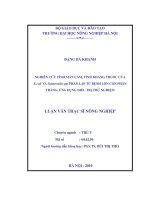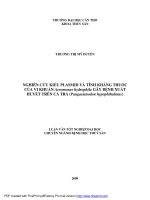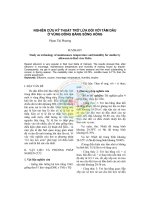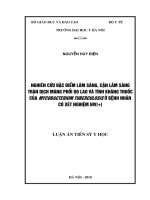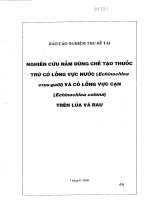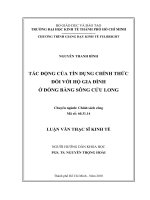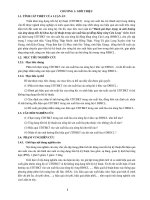Nghiên cứu tính kháng và cơ chế kháng thuốc của cỏ lồng vực nước (echinochloa crus galli) đối với hoạt chất quinclorac tại đồng bằng sông cửu long
Bạn đang xem bản rút gọn của tài liệu. Xem và tải ngay bản đầy đủ của tài liệu tại đây (5.64 MB, 177 trang )
MINISTRY OF EDUCATION AND TRAINING
CAN THO UNIVERSITY
LE DUY
STUDY ON THE RESISTANCE MECHANISM OF
BARNYARDGRASS (Echinochloa crus-galli (L.)
Beauv.) TO QUINCLORAC
IN THE MEKONG DELTA OF VIETNAM
DOCTORAL DISSERTATION
IN PLANT PROTECTION
SUPERVISOR
Assoc. Prof. Dr. NGUYEN MINH CHON
2018
ACKNOWLEDGEMENT
I appreciate all the support from my dissertation supervisor Associate Professor Dr.
Nguyen Minh Chon, Deputy Director of Biotechnology Research and Development
Institute, Can Tho University, and my mentor Dr. Richard K. Mann, Research Fellow
of Dow AgroSciences, Dr. Chon and Dr. Mann are the two scientists who have been
restlessly supporting my career and always provide the valuable advice for this
dissertation.
I am grateful to all of all fellows and friends with whom I have worked together in this
projects. I do appreciate Mr. Nguyen Tan Thuan and Ms. Tran Thi Lai who helped on
the seed collections and the data collection, also Mr. Ngo Thanh Phu who greatly helps
to format the document. Dr. Yerkes, Dr. Cicchillo, Staci, Dave, Debbie and Bill of
Discovery Center, Dow AgroSciences, the dissertation will never be done without your
expertise, my sincere appreciation to all of you.
This dissertation would not have been done without Dr. Hutchin, Dr. Bobba, Dr. Masters
and Sir. Taylor. Your behind the scene support are unmeasurable.
And I would never be able to accomplish my goals without my family.
Tien Giang,…………………….
Le Duy
i
TÓM TẮT
Đề tài được thực hiện nhằm nghiên cứu về tính kháng thuốc cỏ của cỏ lồng vực
(Echinochloa spp.) trên ruộng lúa, 78 mẫu hạt cỏ lồng vực đã được sưu tập từ 7 tỉnh ở
Đồng bằng sông Cửu Long (ĐBSCL). Các nghiên cứu trong luận án tìm thấy các quần
thể cỏ lồng vực kháng thuốc cỏ thuộc nhóm ALS (bispyribac và penoxsulam) và nhóm
thuốc cỏ auxin tổng hợp (quinclorac), giá trị LD90 trung bình của bispyribac, penoxsulam
và quinclorac lần lượt là 33,1; 15,1 và 550,2 g/ha. Kết quả thử nghiệm của thuốc trừ cỏ
rinskor trên các quần thể cỏ lồng vực kháng thuốc cho thấy các quần thể kháng thuốc
trên đều mẫn cảm với rinskor.
Kết quả phân tích kiểu hình cỏ lồng vực trong luận văn cho thấy có 3 nhóm cỏ
chính tương ứng với 3 loài cỏ lồng vực tại ĐBSCL là Echinochloa crus-galli,
Echinochloa oryzoides và Echinochloa erecta, trong đó cỏ lồng vực nước (Echinochloa
crus-galli) là loài phổ biến nhất. Nhằm làm rõ hơn về đa dạng di truyền trong quần thể
cỏ, phương pháp Random amplified polymorphic DNA (RAPD) đã được dùng để phân
tích di truyền của 13 quần thể tại Việt Nam và 2 quần thể cỏ tại Mỹ. Kết quả cho thấy 6
đoạn mồi oligonucleotide cho kết quả 46 băng đa hình trong 15 quần thể, khoảng cách
di truyền của các quần thể trong cây phả hệ là 0,09 đến 0,39. Kết quả của phân tích di
truyền bằng phương pháp RAPD giúp khẳng định mức độ đa dạng di truyền cao trong
quần thể cỏ lồng vực tại ĐBSCL, nhiều loài bị nhầm lẫn với nhau do rất giống nhau về
kiểu hình.
Nhằm làm rõ cơ chế kháng thuốc quinclorac của cỏ lồng vực nước (Echinochloa
crus-galli), nghiên cứu đã tập trung tìm hiểu mức độ phiên mã của gen và mức độ hoạt
động của enzym β-cyanoalanine synthase (CAS) trong lá của 5 quần thể cỏ và lúa sau
khi xử lý thuốc. Kết quả cho thấy ở thời điểm 1 giờ sau khi phun quinclorac, các quần
thể kháng thuốc (R) có thể đẩy nhanh quá trình phiên mã và chuyển hóa thành enzyme
CAS, tốc độ của quá trình này nhanh hơn so với các quần thể mẫn cảm (S). Ở thời điểm
3 ngày sau xử lý , mức độ phiên mã của gene CAS trong các quần thể R giảm về mức
khác biệt không có ý nghĩa so với đối chứng, tuy nhiên mức độ hoạt động của enzyme
CAS vẫn ở mức cao so với đối chứng và quần thể S.
Từ khóa: cỏ lồng vực, cyanoalanide synthase, kháng thuốc cỏ, RAPD,
ii
SUMMARY
The aim of this dissersation was to study the herbicide resistance of the
barnyardgrass (Echinochloa spp.) in 7 provinces of the Mekong Delta of Vietnam,
seventy-eight seed samples of Echinochloa spp. collected from rice field for the study.
The results found the ALS-resistant and synthetic auxin-resistant E. crus-galli were
confirmed at several locations in the Mekong Delta. The average LD90 value of
bispyribac, penoxsulam and quinclorac for assessed weed populations was 33.1, 15.1
and 550.2 g a.i/ha respectively. The new herbicide rinskor was tested in weed
populations exhibited resistance to current herbicides, results showed that the
Echinochloa populations resistant to bispyribac, penoxsulam and quinclorac were
susceptible to the rinskor under greenhouse test.
The morphology analysis indicated there are 3 main groups that corresponding
to 3 species of Echinochloa crus-galli, Echinochloa oryzoides and Echinochloa erecta
found in Mekong Delta, the Echinochloa crus-galli was the most popular species
identified in the study, to extend the study, we used random amplified polymorphic
DNA (RAPD) analysis and greenhouse testing to study the genetic diversity of 15
Echinochloa populations in the Mekong Delta, Vietnam, and the state of Arkansas, U.S.
Six oligonucleotide primers produced 46 bands were polymorphic among the 15
populations. The cluster analysis separated the 15 populations into 2 main clusters with
the genetic distances within the clusters ranging from 0.09 to 0.39. The results of RAPD
are useful to confirm the high diversity of Echinochloa spp. populations in Mekong
Delta of Vietnam, many Echinochloa species with similar morphology could be
confused with the others.
To focus on the mechanism of quinclorac resistance in barnyardgrass
(Echinochloa crus-galli), the research have investigated the transcript and activity of
enzyme β-cyanoalanine synthase (CAS) in leaf tissue of 5 barnyardgrass populations
and rice. One hour post quinclorac treatment, R populations were able to rapidly utilize
CAS transcript to possibly fuel increased CAS protein activity, this process is
significantly higher than the process in S populations. Three days following quinclorac
treatment, the utilization effect on CAS transcript levels had ceased, however, CAS
protein activity remained higher in every population compared to non-treated controls
and S populations.
Keywords: Echinochloa, cyanoalanine synthase, Herbicide resistance, RAPD
iii
STATEMENT ON ACADEMIC INTEGRITY
The results presented in this dissertation is the sole effort of the author, except
where explicitly stated. All references related to the studies are acknowledged and
properly cited. All of data and research results in this document are not published in
publications of any different authors.
Ph.D Student
iv
TABLE OF CONTENTS
Page
SUMMARY ................................................................................................................... iii
TABLE OF CONTENTS .................................................................................................v
CHAPTER 1.................................................................................................................1
INTRODUCTION ........................................................................................................1
1.1
Problem statement ..........................................................................................1
1.2 Targets of dissertation .........................................................................................2
1.3 Studied objectives and limitation of dissertation ...............................................2
1.4 Major research of dissertation ............................................................................2
1.5 Contributions of dissertation ...............................................................................3
CHAPTER 2.................................................................................................................4
LITERATURE REVIEW.............................................................................................4
2.1 Overview of the Mekong Delta in Vietnam and rice cultivation .......................4
2.2 Definitions of weed and herbicide resistance .....................................................5
2.3 Overview of Echinochloa spp. in the rice field ..................................................8
2.4. Herbicide for barnyardgrass control ................................................................10
2.4.1 Overview of herbicidal active ingredient bispyribac .....................................10
2.4.2 Overview of herbicidal active ingredient penoxsulam ...............................11
2.4.3 Overview of herbicidal active ingredient quinclorac .................................13
2.5 Herbicide resistance and testing methods .........................................................15
2.5.1 The importance of herbicide resistance management.................................15
2.5.2 Target site resistance ...................................................................................17
2.5.3 Non target site resistance ............................................................................19
2.5.4 Multiple herbicide resistance ......................................................................23
v
2.5.5 Popular testing methods for herbicide resistance ..........................................24
2.6 Herbicide resistance management strategy ..........................................................31
2.6.1 Minimize weed seed dispersal .......................................................................31
2.6.2 Crop rotation ..................................................................................................31
2.6.3 Herbicide rotation and herbicide mixture ......................................................31
2.7 Reported mechanism of herbicide resistant barnyardgrass (Echinochloa crus-galli) .............32
2.7.1 Herbicide resistance research in Echinochloa spp. .......................................32
2.7.2 Enhancement of β-CAS synthase (detoxification of cyanide) in quinclorac
resistance in Echinochloa spp. ................................................................................34
2.7.3 Modification in the transduction pathway of auxin reception-signal in R and
S Echinochloa plant ................................................................................................36
2.7.4 Other factors associated to the resistance mechanisms to quinclorac in barnyardgrass ....36
2.7.5 Herbicide resistance via pollen mediated gene flow in barnyardgrass ..........37
CHAPTER 3...............................................................................................................37
MATERIALS AND METHODS ...............................................................................37
3.1 Conceptual framework diagram .......................................................................37
3.2 Materials ...........................................................................................................38
3.3 Research methods .............................................................................................42
3.3.1 Survey on farmer practice in rice cultivation and weed management in the
Mekong Delta .........................................................................................................42
3.3.2 Classification of the collected Echinochloa spp. populations based on plant
characteristics..........................................................................................................43
3.3.3 Evaluate the herbicide-resistance level in collected Echinochloa spp.
populations to 3 active ingredients of bispyribac-sodium, penoxsulam and
quinclorac by dose-response screening method ...................................................44
3.3.4 Evaluate the efficacy of rinskor as new herbicide in herbicide resistance
barnyardgrass populations ......................................................................................47
vi
3.3.5 Compare the activity of enzyme β-cyanoalanine (CAS) in quincloracsusceptible and quinclorac-resistant barnyargrass plant to study biochemical
mechanism of quinclorac-resistance in barnyardgrass ...........................................47
3.3.6 Identify genetic variation among quinclorac-resistant and quincloracsusceptible Echinochloa crus-galli populations in the Mekong Delta ...................49
3.3.7 Measure mRNA expression level of CAS gene in quinclorac-resistant and
quinclorac-susceptible barnyardgrass .....................................................................52
CHAPTER 4...............................................................................................................57
RESULTS AND DISCUSSION ................................................................................57
4.1 Herbicide application practice and weed management in rice field at Mekong Delta.........57
4.1.1 Rice cultivation practice .............................................................................57
4.1.2 Important weed species in the rice field at seven provinces of the Mekong
Delta ........................................................................................................................59
4.1.3 Weed management by hand weeding ............................................................60
4.1.4 Weed escaped controlling and the cost on weed management in the Mekong Delta ...........62
4.2 Morphology and distribution of Echinochloa spp. in the Mekong Delta ............64
4.2.1 Plant characteristics .......................................................................................64
4.2.2 Correlation between biological characteristics of Echinochloa plants..........67
4.2.3 Distribution of Echinochloa spp. in the Mekong Delta .................................69
4.3 Herbicide resistant Echinochloa spp. in the Mekong Delta .................................71
4.3.1 Distribution of herbicide resistant Echinochloa spp. in 7 provinces of Mekong
Delta ........................................................................................................................71
4.3.2 Herbicide resistance in three weed groups ....................................................72
4.3.3 The solo resistance and multiple resistance in Echinochloa spp. populations.................73
4.3.4 Evaluate multiple herbicide resistance level by resistance score ..................75
4.3.5 Impact of field size to resistance score under different water management conditions .......76
4.3.6 Correlation between field size and hand weeding .........................................77
vii
4.3.7 The impact of hand-weeding to herbicide resistance of Echinochloa spp. in
the Mekong Delta....................................................................................................78
4.4 Weed control efficacy of rinskor in Echinochloa spp. in the Mekong Delta ......80
4.4.1 Control efficacy of rinskor as a new herbicide against three Echinochloa spp.
groups collected in the Mekong Delta ....................................................................80
4.4.2 Control efficacy of rinskor as new herbicide against Echinochloa spp.
populations collected in Mekong Delta ..................................................................81
4.4.3 Correlation between resistance level of bispyribac, penoxsulam and quinclorac ............82
4.4.4 Efficacy of bispyribac, penoxsulam and quinclorac in susceptible E. crus-galli
compared to resistant plants ....................................................................................84
4.4.5 Efficacy of rinskor for control of susceptible or resistant barnyardgrass to
bispyribac, penoxsulam and quinclorac ..................................................................86
4.5 Biodiversity study by RAPD analysis in 15 barnyardgrass populations from
Vietnam and the U.S ..................................................................................................87
4.5.1 RAPD analysis of 15 barnyardgrass populations ..........................................87
4.5.2 The genetic diversity of Echinochloa crus-galli and herbicide resistance level ............92
4.6 Biochemical mechanism and molecular mechanism of quinclorac resistance in
barnyardgrass .............................................................................................................95
4.6.1 B-CAS activity in 5 quinclorac resistant barnyardgrass populations ............95
4.6.2 CAS transcript abundance in leaf tissue of five barnyardgrass populations ...................97
4.6.3 Biochemical and molecular mechanism of quinclorac resistance in
Echinochloa crus-galli in Mekong Delta ...............................................................99
CHAPTER 5.............................................................................................................101
CONCLUSIONS AND RECOMMENDATIONS ..................................................101
5.1 Conclusions .....................................................................................................101
5.2 Recommendations ...........................................................................................102
REFERENCES ............................................................................................................103
viii
LIST OF TABLES
Page
Table 3.1 List of primers were used for RAPD analysis in the research ....................51
Table 3.2 Steps in PCR reactions ................................................................................53
Table 3.3 RT-qPCR primer sequence detecting β-CAS and β-Actin synthase .......... 53
Table 4.1 Rice cultivation practice of farmer in Mekong Delta ................................. 58
Table 4.2 Farmer perception about important weed species in rice field at 7 provinces
of Mekong Delta ......................................................................................................... 59
Table 4.3 Farmer response about most escaped weed after herbicide treatments and
need hand-weeding to control .................................................................................... 61
Table 4.4 The three most popular herbicides for escaped Echinochloa spp. control in
Mekong Delta ............................................................................................................. 62
Table 4.5 The cost for weed management in Mekong Delta...................................... 63
Table 4.6 Plant characteristic of Echinochloa spp. collected in Mekong Delta ......... 65
Table 4.7 Distribution of Echinochloa species in Mekong Delta .............................. 70
Table 4.8 Herbicide-resistance level in populations to bispyribac, penoxsulam and
quinclorac in different provinces ................................................................................ 71
Table 4.9 Percent of solo-resistance and multiple-resistance herbicides in three groups
of Echinochloa spp. .................................................................................................... 74
Table 4.10 Percent of barnyardgrass population resistant to single and multiple
herbicides of bispyribac, penoxsulam and quinclorac in different provinces ............ 75
Table 4.11 Resistance Score of bispyribac, penoxsulam and quinclorac herbicideresistance of 78 Echinochloa spp. populations........................................................... 76
Table 4.12 Average LD90 of 3 Echinochloa groups to bispyribac, penoxsulam,
quinclorac and rinskor ................................................................................................ 81
Table 4.13 Average LD90 of barnyardgrass population to bispyribac, penoxsulam,
quinclorac and rinskor ................................................................................................ 82
Table 4.14 Six informative primers in RAPD analysis of Echinochloa crus-galli
populations.................................................................................................................. 84
Table 4.15 Lethal dose of quinclorac needed to kill 90% of the population (LD 90) and
the Resistance level of 15 Echinochloa crus-galli populations collected in Vietnam
and U.S ....................................................................................................................... 85
ix
Table 4.16 Mortality of herbicide susceptible (S) and herbicide resistant (R)
barnyardgrass treated by rinskor at different dose ..................................................... 86
Table 4.17 Six informative primers in RAPD analysis of Echinochloa crus-galli
populations.................................................................................................................. 88
Table 4.18 Lethal dose of quinclorac needed to kill 90% of the population (LD 90) and
the Resistance level of 15 Echinochloa crus-galli populations collected in Vietnam
and U.S ....................................................................................................................... 93
x
LIST OF FIGURES
Page
Figure 2.1 Soil distribution map of Mekong Delta....................................................... 5
Figure 2.2 Echinochloa crus-galli flower at mature stage ........................................... 9
Figure 2.3 Infestation of Echinochloa crus-galli in rice field of Long An province, July 2016 ... 9
Figure 2.4 Chemical structure of bispyribac .............................................................. 10
Figure 2.5 Process of manufacturing penoxsulam from N-(triazolo[1,5-a]pyrimidine)
sulfonamides ............................................................................................................... 12
Figure 2.6 Molecular structure of quinclorac ............................................................. 13
Figure 2.7 Chronological increase in Resistant Weeds Globally ............................... 16
Figure 2.8 GST-catalyzed detoxification of atrazine in plants ................................... 21
Figure 2.9 The minimal ABC transporter has four domains. Two transmembrane
domains (TMDs) bind ligand, and transport is driven by ATP binding and hydrolysis by
the two nucleotide binding domains (NBDs) ............................................................. 23
Figure 2.10 Plant nursery for herbicide screening test ............................................... 26
Figure 2.11 Results of herbicide screening in different weed populations ................ 26
Figure 2.12 Dose response curves for a Susceptible (S) and a Resistant (R) population ............ 27
Figure 3.1 The workflow designation ........................................................................ 38
Figure 3.2 The map of sampled barnyardgrass .......................................................... 40
Figure 3.3 Prepare the barnyardgrass seedling for herbicide screening ..................... 41
Figure 3.4 Symptom of bispyribac in barnyardgrass leaf .......................................... 45
Figure 3.5 Symptom of penoxsulam in barnyardgrass leaf ........................................ 46
Figure 3.6 Symptom of quinclorac in barnyardgrass leaf .......................................... 46
Figure 3.7 Symptom of rinskor in barnyardgrass leaf ................................................ 46
Figure 3.8 Ninety-six wells microplate for the spectrophotometer reading at wavelength 650Å.......49
Figure 3.9 β-CAS gene mined from the in-house ECHCR transcriptome ................. 54
Figure 4.1 Mosaic plot diagram of hand-weeding practice after herbicide application in
71 survey fields in Mekong Delta .............................................................................. 60
Figure 4.2 Flowers of three Echinochloa spp. groups in the study ............................ 66
xi
Figure 4.3 Correlation between plant height and shoot dry weight of three Echinochloa
group ........................................................................................................................... 67
Figure 4.4 Correlation between panicle emerged date and grow duration of three
Echinochloa groups .................................................................................................... 68
Figure 4.5 Resistance level of three Echinochloa groups to bispyribac, penoxsulam and
quinclorac in different provinces ................................................................................ 73
Figure 4.6 Correlation between Resistance Score and field size under different water
management conditions .............................................................................................. 77
Figure 4.7 One way ANOVA t-test for field size and hand-weeding practice .......... 78
Figure 4.8 One way ANOVA t-test for the impact of hand-weeding to herbicide
resistance in rice field ................................................................................................. 79
Figure 4.9 Correlation between LD90 value of herbicides in barnyardgrass ...................... 83
Figure 4.10 Electrophoresis image of 6 primers produced polymorphic bands ......... 89
Figure 4.11 The dendrogram of 15 Echinochloa crus-galli populations from Vietnam
(CT-10, KG-01, TG-03, HG-06, HG-02, CT-08, HG-03, CT-04, VL-03, HG-01, CT-02,
CT-01, VL-01) and U.S (A-S, AR) ............................................................................ 90
Figure 4.12 Geographic distribution of 13 Echinochloa crus-galli populations collected
in the Mekong Delta, Vietnam ................................................................................... 91
Figure 4.13 Mode of action of quinclorac in E. crus-galli and the process to measure the
activity of CAS after quinclorac treatment ................................................................. 95
Figure 4.14 LD50 and % Mortality of 5 barnyardgrass populations foliar-treated by
quinclorac ................................................................................................................... 95
Figure 4.15 Activity of enzyme CAS (nmol H2S/100ug/minute) in barnyardgrass leaf
tissue treated by quinclorac.. ...................................................................................... 97
Figure 4.16 CAS transcript abundance was significantly decreased 1 hour after quinclorac
treatment in resistant populations Ech_03, Ech_04, Ech_05 and Oryza sativa however, remained
unchanged in susceptible populations Ech_01 and Ech_02 ................................................ 98
Figure 4.17 Three days following quinclorac treatment, CAS transcript abundance was
not significantly different than the non-treated controls in all populations except for
Ech_02 where data is unavailable .............................................................................. 99
xii
LIST OF ABBREVIATIONS
ALS
Acetolactate synthesis
ACCase
Acetyl CoA Carboxylase
CAS
Cyanoalanide synthase
LD90
Lethal Dose of 90% of population
PCR
Polymerase Chain Reaction
RAPD
Random Amplified Polymorphic DNA
RT-qPCR
Real-time Polymerase Chain Reaction
xiii
CHAPTER 1
INTRODUCTION
1.1 Problem statement
According to Moody (1988) weed competition in flooded rice fields might
decrease grain yield by 25%. In several cases, uncontrolled weeds on dry directseeded rice could impact up to 50% yield loss on rice (Chauhan, 2012). To date,
approximately 388 biotypes of 210 species that showed resistance to herbicides
had been documented (Caseley et al. 2013). Among key weeds in the field, the
barnyardgrass (Echinochloa crus-galli) had been considered as the most
notorious for a long time, as a C4 plant, the growth rate of barnyardgrass is far
dominant to rice (Caton et al. 2004). In addition, Echinochloa crus-galli and
Echinochloa colona can mimic the rice appearance at the early stage of weed
seedlings, the similarity in plant appearance make it hard to control by hand
weeding (Chauhan, 2012).
Herbicides still play an important role as the most effective method in
weed management on rice fields, however, herbicide resistance is an certain
issue. From 1994 to 2014, the number of herbicide resistance cases on rice
culture is 32 species in 25 countries and 8 Mode of Action (MoA) groups.
Among 127 reports over the world, 43 instances were reported on barnyardgrass
(Echinochloa spp.), in which, 12 out of 43 cases resisted to group B
(Acetolactate synthase inhibitors) and 7 out of 43 cases resisted to group O
(Synthetic auxins). These reports also included one case that resisted to both
MoA groups (Heap, 2014).
The barnyardgrass could evolve resistance to several current herbicide
active ingredients, especially to two groups of B and O. In this situation, further
research about herbicide resistance in barnyardgrass is critical. In recent years,
there are many methods to study herbicide resistance including bioassay with
screening and DNA analysis, such as Rapid Whole-Plant Assay for PostApplied Herbicides, Seed Germination Assays, Agar-Based Seedling Assays,
Leaf Disc Assays, Pollen Germination Test, DNA-Based Assays (Burgos et al.,
2013).
Today herbicide testing methods exhibit particular advantages and
disadvantages. For multiple study purposes, a single or combination of several
methods could be utilized. Based on targets of research, Rapid Whole-Plant
Assay for POST-Applied Herbicides and Seed Germination Assays would be
suitable to identify the herbicide resistance level of weed, and DNA-Based
Assays would be appropriate to detect the resistant gene in weed biotypes. As
1
an outcome, the dissertation of “Study on the resistance mechanism of
barnyardgrass (Echinochloa crus-galli) to quinclorac in the Mekong Delta of
Vietnam” was proposed.
1.2 Targets of dissertation
Evaluate the morphological variability and genetic diversity of
Echinochloa spp. populations in Mekong Delta of Vietnam.
Evaluate the herbicide-resistance level of Echinochloa spp. to bispyribac,
penoxsulam and quinclorac in rice fields at the Mekong Delta of Vietnam.
Explain the biochemical mechanism and the molecular mechanism of
quinclorac-resistance in Echinochloa crus-galli.
1.3 Studied objectives and limitation of the dissertation
This study is limited to rice fields in the 7 provinces of Mekong Delta of
Vietnam (Long An, Tien Giang, Vinh Long, Can Tho, An Giang, Hau Giang
and Kien Giang).
The targeted weed in the study is Echinochloa spp., the weed was
examined for herbicide-resistance evaluation and mapping purpose. The
Echinochloa crus-galli is main species studied for quinclorac-resistance
mechanisms at the biochemical and molecular level.
1.4 Major research topics of the dissertation
(1) Survey the rice cultivation and weed management practice in rice fields
at the Mekong Delta of Vietnam.
(2) Evaluate the diversity of Echinochloa spp. population in rice fields at
the Mekong Delta of Vietnam.
(3) Evaluate the herbicide-resistance level of the collected Echinochloa
spp. samples to bispyribac-sodium, penoxsulam and quinclorac by doseresponse screening method.
(4) Evaluate the efficacy of rinskor, a new herbicide against the herbicideresistant Echinochloa crus-galli to find new effective herbicide for current
herbicide-resistant barnyardgrass.
(5) Use RAPD analysis to evaluate the genetic diversity of Echinochloa
crus-galli populations, and the correspondence of quinclorac-resistance and
genetic distance of Echinochloa crus-galli populations in the Mekong delta
(6) Measure the activity of β-cyanoalanine synthase in the leaf tissue of
Echinochloa crus-galli to study the biochemical mechanism of quincloracresistance in barnyardgrass.
2
(7) Measure the expression level of mRNA of CAS gene in barnyardgrass
to study the molecular mechanism of quinclorac-resistance in barnyardgrass.
1.5 Contributions of dissertation
This research presents useful information about the diversity of
Echinochloa spp. in the rice field of Mekong Delta of Vietnam (Mekong Delta),
which will be important for further study about this weed species.
The most important result of this study is data about the herbicideresistance of Echinochloa spp., the research has confirmed the existence of
herbicide-resistant Echinochloa spp. populations in Mekong Delta. This
research also evaluates the relationship between farmers’ weed management
practice and the herbicide-resistance, therefore, the practical solutions for
herbicide-resistant weed were also determined and suggested in the dissertation.
The mechanisms of quinclorac-resistance in barnyardgrass were
confirmed and elucidated at enzyme and molecular level, through the
measurement of quinclorac detoxifying enzyme activity and its gene expression
level in barnyardgrass. The results establish important information for the
further study about the mechanism of the herbicide-resistance in weeds.
3
CHAPTER 2
LITERATURE REVIEW
2.1 Overview of the Mekong Delta in Vietnam and rice cultivation
Vietnam is one of the top rice exporters globally. In 2015, about 45 million
tons of rice was produced in Vietnam, of which 22.4% was exported, and the
remaining was for domestic consumption (USDA, 2017). For several years, rice
is one of the most important crops in Vietnam with approximate 7.6 million
hectares cultivated in the country (General statistics office of Vietnam, 2017).
Moreover, about 55% of rice in the country was grown in the Mekong Delta,
and the average yield of this region was 5.96 ton/ha (General statistics office of
Vietnam, 2017) which was 38% higher than the global average yield
(FAOSTAT, 2017).
Mekong Delta, Vietnam is an area of 40,577 km2. This is the most
downstream part of the Mekong River, the total population is over 17 million
with 3.96 million hectares for agriculture activities (Le Anh Tuan et al., 2007).
Mekong Delta produces more than 50% of cereal food for all of Vietnam. Rice
exportation from this area is one of the most important income for the country,
54% of rice in the Delta was cultivated during the Summer-Autumn season
(May to August); resulted in the highest yield harvested during Winter-Spring
season (January to April), which could be 20.5% higher than average of the year
(Nguyễn Hoàng Dân et al., 2015).
Average field size per household in the Mekong Delta is 1.29 ha, higher
than average size in the country which is 0.44 ha. Although the area of rice
growing has reduced since 1980, the rice farming system now changes to an
intensification model, in 2010 there was 530,000 ha growing rice in triple crops
per year compared to 23,000 ha in 1980 (Nguyễn Đức Thành và Đinh Tuấn
Minh, 2015). The average cost of pesticide per season in this area was 17-20%
(Hồ Cao Việt, 2011).
The Mekong Delta natural condition is divided by 12 soil types (Fig 2.1),
and their distribution influences the local agricultural activities and rice
production (Minh, 2002). 80% of the total surface water used for rice growing
areas, the intensive rice growing areas are located in upstream and midstream
provinces (Dang Kieu Nhan et al., 2007).
In recent year, water shortage and the saline water intrusion are one of the
major threats for rice cultivation in Mekong Delta. Saline water could intrude
far into the irrigation system of many provinces in the dry season of 2016,
4
majority areas of Vam Co River (about 90 km away from the sea) were impacted
by the intrusion (Lê Anh Tuấn, 2016).
Figure 2.1 Soil distribution map of Mekong Delta (Minh, 2002)
2.2 Definitions of weed and herbicide resistance
There are many definitions for weed, and one of the well-known
definitions is “The plant growing where it is not wanted” (Blatchley, 1912;
Zimdahl, 2013). The most troublesome aspect of weeds is crop competition,
but sometimes some weed species are also prone to cause strong allergies (e.g.
hay allergies) and skin dermatitis in sensitive individuals (Molinar, 2002).
Weeds are considered as one of the most costly factors in controlling and
limiting crop production globally as yield losses caused by weeds mainly come
from direct competition with crop plants for water, nutrients, light, and space
(Rosskopf et al., 1999). The peculiar biological traits of weeds, including seed
dormancy, germination, and emergence over long periods of time, long-term
survival of buried seeds, abundant seed production, rapid population
establishment, capacity to colonize new sites, and multiple adaptations for
5
spread, can provide weeds evolutionary advantages over cultural plants and
crops (Molinar, 2002).
In most cropping systems, weeds can significantly reduce crop yields,
plant for animal feeding and also fiber quality (Rosskopf et al., 1999). Besides
the direct impacts, weeds can also serve as alternate hosts to insect pests and
pathogens in the field, in consequences lead to higher operating costs and
increased risk of diseases (Wisler and Norris, 2005). There are several reports
about the Echinochloa crus-galli serves as host for virus transmitting brown
plant hoppers in the rice field at the end of the rice season (Hattori, 2001) and
Zhou et al. (2008).
Weed control is an important practice for any intensive cropping system.
There are several methods for weed management in the field including
mechanical based weeding (weeding by hand, tool, machine or laser transmitter
to burn the plant), chemical based (herbicide), crop competition model
(allelopathy), and biological control (parasite insect, fungi, grazing cattle or
other herbivores). For crop production in large scale, the chemical based method
is still the most reliable and cost-effective solution for weed management
(Harker and O’Donovan, 2013). Several bio-herbicides like pathogen or plant
extractions are also studied, but the effect is still limited in large scale
application (Van-Driesche and Bellows, 1996).
After the herbicide introduced in the market, the evolution of the
herbicide-resistance in weeds had already been predicted by Blackman (1950).
The first case of atrazine and simazine resistance Senecio vulgaris was found in
1968 and first reported in the USA in 1970, this type of weeds had evolved
resistance to herbicides inhibiting the electron transport in photosystem II (PSIIinhibitors) after the herbicides had been applied once or twice annually for 10
years (Ryan, 1970), the herbicide-resistance report was continued by
Radosevich and Appleby (1973) for Amaranthus retroflexus L.
The definition of the herbicide-resistance has been mentioned by several
authors, according to Heap et al. (1993), the herbicide-resistance is “the evolved
capacity for a previously herbicide-susceptible weed population to withstand a
herbicide and complete its life cycle when the herbicide is used at its normal
rate in an agricultural situation”.
The Herbicide Resistance Action Committee (HRAC, 2017) defines
herbicide resistance as “the naturally occurring inheritable ability of some weed
biotypes within a given weed population to survive a herbicide treatment that
6
would, under normal use conditions, effectively control that weed population.
Selection of resistant biotypes may result in control failures”.
The WSSA (Weed Science Society of America. 1997) also distinguish the
herbicide-resistance to herbicide-tolerance as:
- Herbicide resistance is the inherited ability of a plant to survive and
reproduce following exposure to a dose of herbicide normally lethal to
the wild type. In a plant, resistance may be naturally occurring or induced
by such techniques as genetic engineering or selection of variants
produced by tissue culture or mutagenesis.
- Herbicide tolerance is the inherent ability of a species to survive and
reproduce after herbicide treatment. This implies that there was no
selection or genetic manipulation to make the plant tolerant; it is naturally
tolerant.
The European and Mediterranean Plant Protection Organization
(OEPP/EPPO) describes the herbicide-resistance as “the naturally occurring, inheritable adjustment in the ability of individuals in a population to survive a
plant protection product treatment that would normally give effective control.”
The EPPO guidelines introduce a difference between resistance that can be
verified at the laboratory level and resistance observed in the field situation,
which is referred to as “practical resistance” and defined as “the loss of field
control due to a shift in sensitivity”. According to this distinction, the detection
of herbicide resistance at the laboratory level does not always connect to the
reduction of that pest control in the field (EPPO, 1988).
Herbicide-resistant individual plant normally exists in any weed
populations at a lower level before application of herbicide, but the continuous
selection pressure imposed by herbicides on plants allows the resistance to
increase in frequency (Jasieniuk et al., 1996). A number of factors contribute to
the evolution of herbicide resistance in any weed species including frequency
of resistant alleles in a population, number and mode of herbicide applications,
efficacy of used dosage, seed bank in soil, and other biological factors (Preston
and Powles, 2002).
In general, apart from the pre-existing resistant population, the movement
of genes (via seeds or pollen depend on species) from resistant populations in
nearby fields also becomes the source of new resistant genes in the gene pool of
population. The gene mutations associated to the resistance to a specific
herbicide class are not induced by application of the herbicide, but rather to
occur naturally (Jasieniuk et al., 1996).
7
2.3 Overview of Echinochloa spp. in the rice field
The genus Echinochloa includes over 250 species, and most of these are
considered as weeds. Weed species belonging to Echinochloa are varied in their
growth habit, distribution, and morphology (Barrett and Wilson, 1983).
Barnyardgrass (Echinochloa spp.) is C4 monocots (Caton et al., 2010). This
weed originated from Europe and has been now documented worldwide (Dorie
and McNeill, 1980). The morphology of Echinochloa spp. is highly diverse, in
many cases, there are several species confused with one another. Many species
have been misidentified as Echinochloa crus-galli because of this species high
popularity. In many places of the world, the barnyardgrass is a popular local
name for weeds in Echinochloa family, in fact, many different species that were
misnamed as Echinochloa crus-galli (Rutledge et al., 2000)
Echinochloa crus-galli has spread across 61 countries in the world and
been considered as a severe weed in 36 crops (Bajwa et al., 2015). This weed is
highly adapted to a wider range of photoperiods. Due to the continuous
morphological variations among species, the classification of Echinochloa has
remained a serious problem for weed scientists (Damalas et al., 2008).
According to Ampong-Nyarko and Datta (1991), the optimal condition for
barnyardgrass is high soil moisture (70% to 90%). Its seeds can germinate under
water, however, the germination rate is inversely proportional to the depth of
water. During the first stage of vegetative growth, it is nearly impossible to
distinguish between the rice plants and barnyardgrass. This can be seen as a
result of phenotypic evolution, and the pressure for this evolution is a very long
period of hand weeding in rice cultivation.
In Asia, rice fields have three main barnyardgrass species, Echinochloa
crus-galli, Echinocloa colona, and Echinochloa glabrescens, which found in
Vietnam (Koo et al., 2005). The barnyardgrass (Echinochloa crus-galli) is a
highly competitive weed in rice field because of large biomass and seed
producing capability as one plant can produce 2000 to 4000 seeds in ideal
condition (Gibson et al., 2002).
Barnyardgrass (Echinochloa crus-galli (L.)) is a problematic weed
worldwide since it possesses a C4 photosynthetic pathway, which is biologically
more advantageous than C3 Poaceae crops such as rice. As a more significant
competitor to rice, barnyardgrass could spread their seeds at a tremendous level,
causing up to 80% reduction in rice yield (Van-Devender et al., 1997).
There are about 400 weed species reported in upland crops and rice fields
of Vietnam; among those weeds, barnyardgrass (Echinochloa crus-galli) is one
8
of the most critical grass weeds in rice fields as this weed can reduce
approximately 25% rice yield under high infestation condition (Chin, 2001).
Report of Chu Van Hach et al. (1998) also mentions a significant negative
relationship between grain yield and barnyardgrass’ dry matter accumulation.
Barnyardgrass density at 258 and 340 plants/m2rice caused yield losses were
about 86.7% in first season and 63.5% in second season.
Study results of Hoang Vu Duy et al. (2013) showed that photosynthetic
rate and dry matter accumulation rate of barnyardgrass were higher than those
of rice at all growth stages although stomatal conductance, transpiration rate and
SPAD value of rice were higher than those of barnyardgrass. The photosynthetic
rate, dry matter accumulation rate and nitrogen content in leaves also increased
in both rice and barnyardgrass as nitrogen levels increased.
Ho Le Thi et al. (1998) also stated that Echinochloa crus-galli is one of
the most troublesome weeds in Mekong Delta because it could serverely reduce
rice yield in both quantity and quality. Furthermore, 60-80% of the nitrogen
from soil and considerable amounts of other macronutrients can be removed by
barnyardgrass (Maun and Barrett, 1986).
Heap (2017) mentioned that the majority of Echinochloa spp. were
resistant to almost all available active ingredients in the market. 43 out of 127
reported cases of herbicide resistance on grass involved barnyardgrass species,
among which Echinochloa crus-galli in Brazil showed resistance to both B and
O MoA.
Figure 2.2 The
Echinochloa crus-galli
flower at mature stage,
Long An province, July
2016
Figure 2.3 Infestation of
Echinochloa crus-galli in rice
field of Long An province,
July 2016
Allelopathy has been recognized as a strong mechanism of weed invasion
in the field since the allelochemicals found in the root zone of weed could inhibit
the crop growth (Lorenzo et al., 2013). Echinochloa crus-galli is a troublesome
weed with strong allelopathic competition potential in many crops (Chung et
9
al., 2001). In 2006, a study was conducted to identify and isolate 15
allelochemicals from Echinochloa crus-galli root exudates, all of these
allelochemicals belong to different chemical classes that inhibit growth in
various plants (Xuan et al., 2006).
2.4. Herbicide for barnyardgrass control
2.4.1 Overview of herbicidal active ingredient bispyribac
Figure 2.4 Chemical structure of bispyribac (NCBI, 2017)
The Bispyribac-sodium or pyrimidinyl carboxy herbicide bispyribac
sodium (sodium 2,6-bis[4,6 dimethoxypyrimidine- 2-yl)oxy]benzoate) is a
Class D growth regulator, the herbicidal effect of this molecule was first
investigated by Fagerness and Penner in 1998. Bispyribac-sodium is readily
absorbed by roots and translocated to shoots (Lycan and Hart, 2006). The
bispyribac-sodium was used for selective post emergence control of
Echinochloa crus-galli (L.) Beauv. (Williams, 1999) and many other
problematic weeds in rice (Martini et al., 2015a).
Bispyribac-sodium is a systemic herbicide that moves from
photosynthetically active leaves to meristematic regions of plants, to achieve
optimum weed control efficacy, a certain amount of herbicide needs to reach
these zones, causing the death of susceptible plants (Murata and Los, 1997;
Martini et al., 2015a).
Bispyribac-sodium could damage rice seedling, the herbicide effect rice
by making foliar injury, root growth inhibition, and root dry weight reduction
(Devine, 1989; Devine et al. (1990); Shaner, 1991; Dunand and Dilly, 1994;
Braverman and Jordan, 1996). Zhang and Eric (2002) proved that rice plants
are tolerant to bispyribac sodium depending on the cultivars and growth stage
of seedling, bigger rice seedling are more tolerant to the herbicide compared to
smaller plant.
10
Bispyribac-sodium affects the plants by inhibit Acetolactate synthase
(ALS), also called Acetohydroxyacid synthase (AHAS), a key enzyme in the
biosynthesis of the branched-chain amino acids isoleucine, leucine, and valine.
Plant dies as a result of ALS inhibition and low branched-chain amino acid
production reduction in leaf tissues, and because the inhibition of amino acid
production happens gradually, it could take several days to see the symptoms of
damage in weed foliar (LaRossa and Schloss, 1984; Shimizu et al., 1994, 2002;
Osuna et al., 2002).
According to Martini et al. (2015b), cytochrome P450 monooxygenase
(P450s), a large membrane-bound enzyme family, is the key enzyme that
metabolize the bispyribac-sodium in plant tissue. This enzyme could metabolize
many herbicides, including bispyribac, propanil and various ALS inhibitors.
Low temperature promotes membrane rigidification, which will lower the P450
activity, contributing to reduction in herbicide metabolism and increasing
herbicide damages on rice plants.
Bispyribac-sodium resistance has been reported in barnyardgrass
Echinochloa phyllopogon, Echinochloa oryzicola (Fischer et al., 2000) and a
cross resistance in Echinochloa phyllopogon and Cyperus difformis. The reason
is due to the increase of cytochrome P450 monooxygenation by inhibitors and
target site alteration (Osuna et al., 2011). The cytochrome P450 enzyme could
be inhibited by the organophosphate pesticide like Malathion because
application of Malathion could increase the susceptibility of bispyribac-resistant
weed (Murata and Los, 1997).
In Vietnam, bispyribac is also a common herbicide for controlling
barnyardgrass and broadleaf weeds in the rice field. This product is widely used
as a solo product or mixture with other herbicides. Some brands of bispyribacsodium (min 93%) are Nominee (10SC and 100OF manufactured by Kumiai
Chem. Ind. Co., Ltd), Nonee-cali (10WP and 100SC manufactured by Cali Parimex Inc), and Sunbishi (10SC manufactured by Sundat (S) Pte Ltd). Based
on labeled recommendation of Kumiai Chem, bispyribac 100OF is highly
effective against barnyardgrass and broadleaf weeds, and the product should be
used at 2-4 leaf stage of barnyardgrass (Plant Herbicides Permitted in Vietnam
2013, Ministry of Agriculture and Rural Development).
2.4.2 Overview of herbicidal active ingredient penoxsulam
The penoxsulam is a herbicidal active ingredient in group B (ALS
inhibitor). This herbicide was developed from N-(triazolo[1,5-a]pyrimidine)
11
